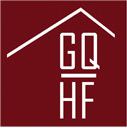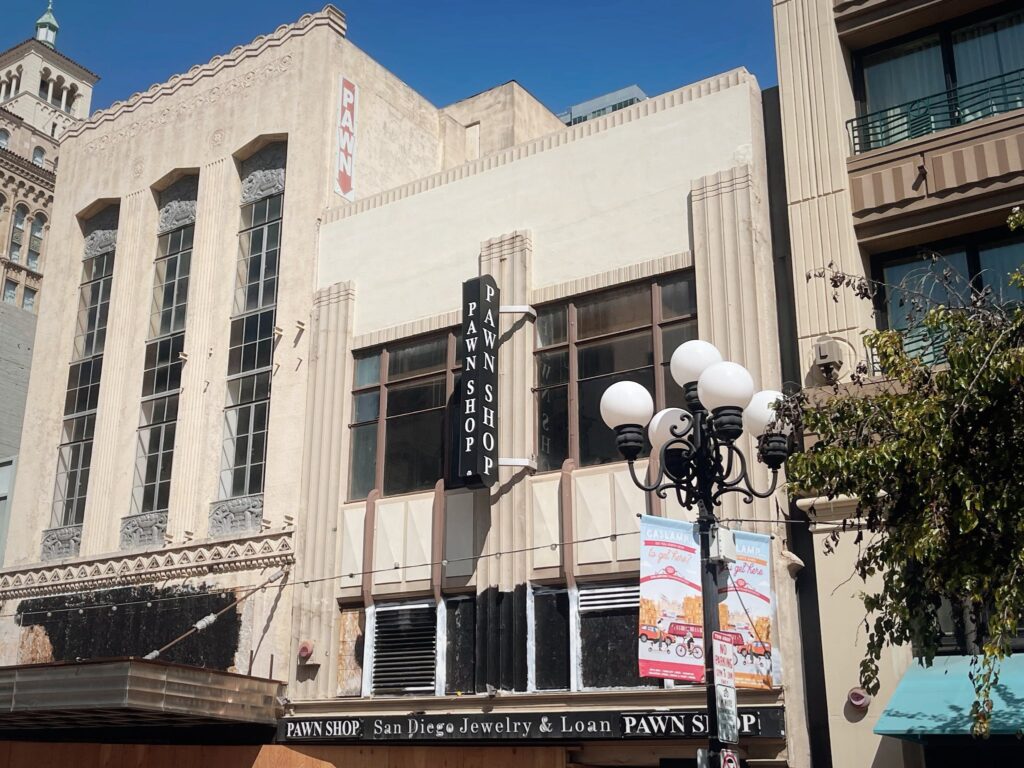Landmarks
Style is the Thing!
Flagg Bros. Shoe Store
c.1902
931 Fifth Avenue
Architectural Style: Commercial
Architect: Unknown
Some buildings are built with no particular vision for what they will become, and simply evolve into a myriad of businesses and uses. The commercial structure at 931 5th, and its wooden predecessor, were built to house respectable businesses and continued to do so for many years. It was, and still is, a no-frills structure, and still stands with very few alterations.
The first owner of the lot was Anthony DeFrees. He purchased the property from Alonzo Horton for $1,000, with the intention of constructing a brick building to house a wholesale and retail boot and shoe company. Prophetic? His vision never materialized, and the lot went through several subsequent ownerships before the south half was sold to Charles T. Signor. It was he who constructed the first building on the property – a 40×20, one-story frame structure with a shingle roof. In the rear of the building were two small sheds – one used for storage and the other marked as a sleeping room. Zengeler’s Saloon first occupied the building in 1887, followed by the People’s Hall in 1892.
In 1888, the south part of the lot was purchased by none other than Ephraim Morse and Thomas Whaley – two household names in early San Diego history and development. In 1890, Whaley died of a heart attack, and by 1893, the entire lot was owned by Bryand Howard, who purchased the property from Morse.
Howard was one of San Diego’s most colorful citizens – in both good and bad ways. He helped organize the Savings Bank of San Diego, which he then combined with the Consolidated Bank. Unfortunately, both banks failed. The San Diego Union stated that many of Howard’s transactions were “questionable and dishonest in nature.” They went on to say that the bank collapse was due to Howard’s “mental deterioration and paralysis while continuing to be in full authority and exercising a dictatorial power over its affairs.” On the other hand, he worked tirelessly to gain terminal facilities for the Texas Pacific Railroad and served as President of the San Diego Flume Company and several other large corporations. Before his death in 1901, he had transferred most of his properties to his wife’s name.
Although the architect and the actual date of construction were not filed, a building was entirely completed on the property by 1904. The edifice was a two-story, brick structure, 50’x 90’, with a composition roof. There were two storefronts on the first floor and several offices on the second floor. Two large bay windows graced the rear, while a lightwell provided natural light into the second floor. The front windows were accented by raised concrete pilasters.
One of the first businesses to occupy the building was the Hamilton Brothers Grocery Store. For many years, this store, both at this and other additional locations, was San Diego’s most prominent grocery business, dealing in both domestic and foreign foods.
By 1905, several other businesses became tenants. They included Dr. C.S. Murphy (physician), Dr. J.A. Watts (dentist), Van Horne & Blockman (collection agents), G. J. Vreeland and S.W. Stout (photographers) and H.K. Coon (real estate and insurance). Additional tenants were another real estate agent, two more dentists, and a tailor.
The south side of the building, where the original frame saloon had stood, now housed Hans Marquardt, clothing. By 1926, it had become the Chinese Toggery, ladies ready-to-wear. Three years later, it housed the National Dollar Store, dry goods, who remained for four years until they moved down the street.
After the Hamilton Grocery Store vacated the adjoining storefront, it was followed by the Reliable Shoe Company. Divine intervention to a prophetic dream? It was followed by the Lewis-Boldrick Shoe Store, who was followed by the Lewis Shoe Store. Following all the shoe stores, this humble storefront became an annex of the well-known Whitney Department Store.
The shoe business was not done yet though! In more modern times, throughout the 60s – 80s, this building became the home of Flagg Bros. Shoes, a very popular, nationally recognized shoe store chain. In fact, Flagg Bros. shoes became so popular that they are represented in the Brooklyn Museum Costume Collection of the Metropolitan Museum of Art in New York! Throughout the 50s and 60s, Flagg Fliers, one of their most popular styles, were the foot coverings of the elite. They were most common in black leather, but sometimes available in “white buck.” They were the shoes of choice for Pat Boone, a popular singer and film star, and it is rumored that he still wears them.
In November of 1961, when the Grossmont Shopping Center was opened, Flagg Bros opened a branch store there. Along with Montgomery Ward, it is now gone. Although it looks much different now, the shopping center or mall, is still there.
Throughout the ’70s and ’80s, the era of flared trousers and platform shoes, they advertised the “hippest styles in the baddest colors at a price you can afford.” One could even secure a Coutre Catalog for free! For those of you who are salivating at the thought of strutting around in a pair of these platform beauties, they can now be found on Etsy. Of course, they aren’t “at a price you can afford” any longer! One could say that Mr. Defrees, the original owner of the property, finally had his dream realized!
The latest tenant of the Flagg Bros building was the San Diego Jewelry and Loan Pawn Shop. This enterprise is gone, and this sturdy little building sits in silent disrepair just waiting for a new tenant. All it seems to need is a good painting job to remove all the graffiti. How about a nice book and tea shop?
Sandee Wilhoit is the Historian/Lead Tour Guide for the Gaslamp Quarter Historical Foundation.
She can be reached at [email protected].

